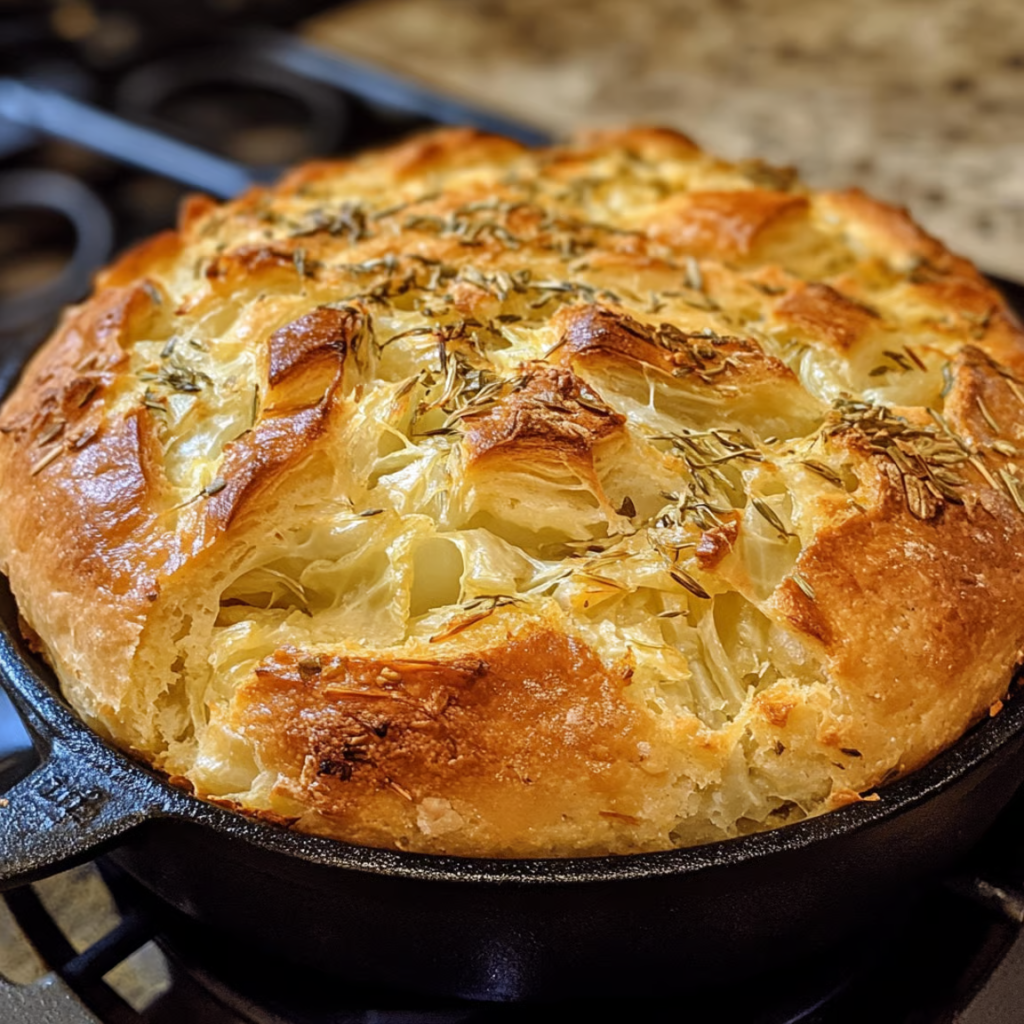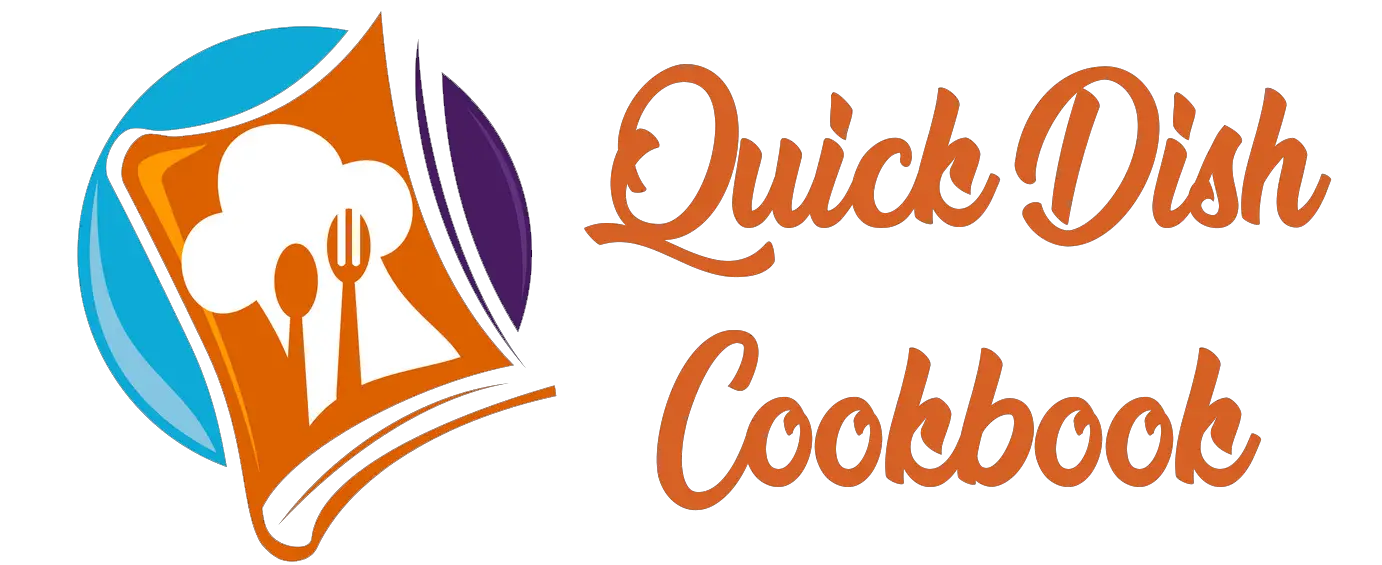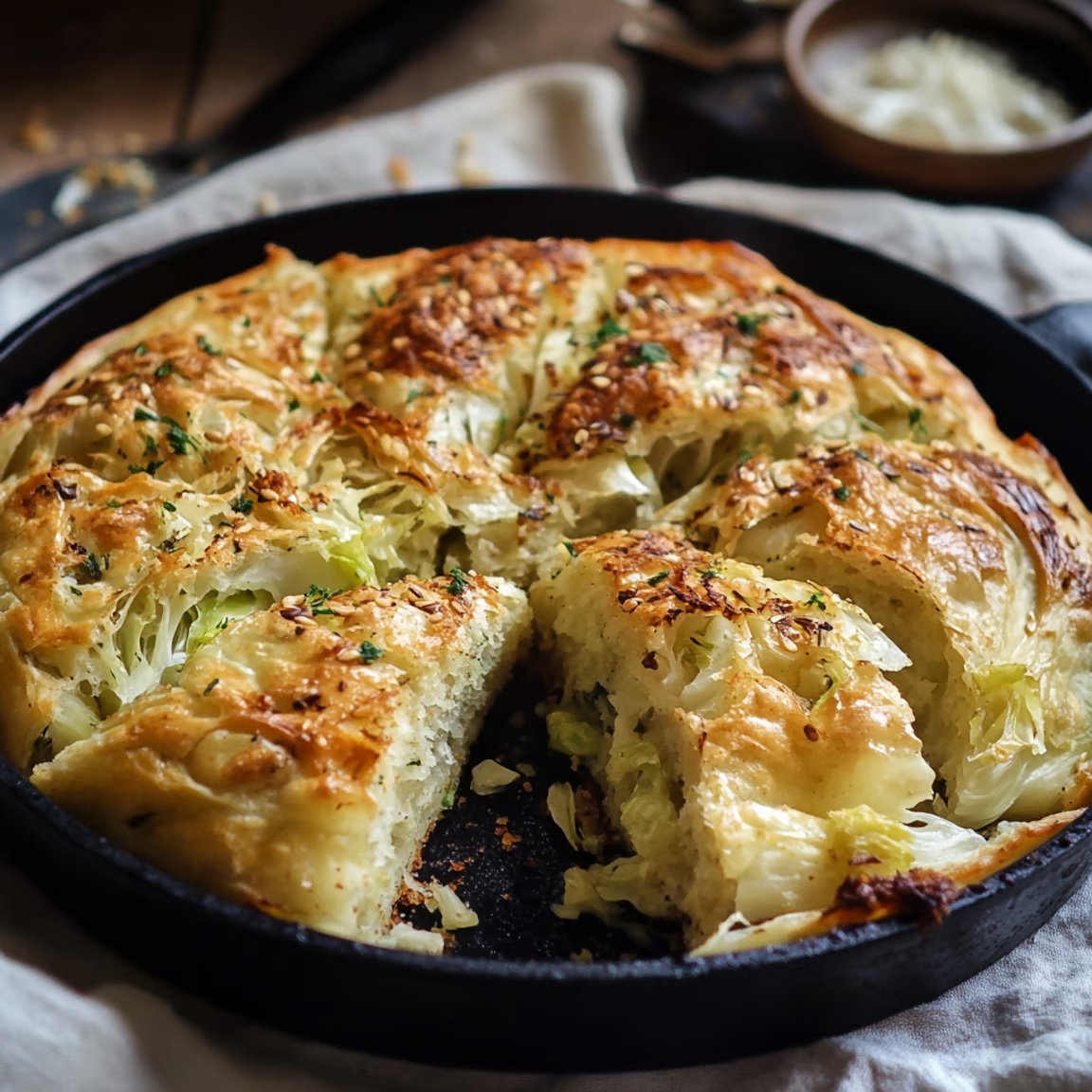Table of Contents
Cabbage bread is a unique, tasty twist on traditional bread. It’s healthier and packed with flavor.
If you’re looking to add more veggies to your diet, cabbage bread is perfect. This recipe combines the goodness of cabbage with the comforting texture of bread. Whether you’re a seasoned baker or a beginner, making cabbage bread is easy and rewarding.
Imagine the savory aroma filling your kitchen as you bake this wholesome treat. Plus, it’s a great way to sneak in extra nutrients without compromising on taste. Intrigued by this delicious idea? Get ready to learn how to make cabbage bread that’s sure to impress your family and friends. Let’s dive into this exciting recipe and discover a new favorite!
Ingredients Needed
Creating a delicious Cabbage Bread Recipe at home can be both fun and rewarding. This unique Vegetable Bread combines the health benefits of cabbage with the comforting texture of homemade bread. Here are the ingredients needed to make this savory Yeast Bread Recipe.
Fresh Cabbage
Cabbage is the star ingredient in this Cabbage Bread. It provides a unique flavor and adds nutrients. Here are the steps to prepare the cabbage:
- Choose a fresh, firm cabbage.
- Remove the outer leaves.
- Wash the cabbage thoroughly.
- Shred or finely chop the cabbage.
Cabbage Nutrition includes vitamins C and K, as well as fiber. These nutrients make Cabbage Bread a Healthy Bread Option. Including cabbage in bread also adds moisture, making the bread soft and delicious.
Bread Flour
Choosing the right bread flour is crucial. It provides the necessary structure for the bread. Here are some options:
| Type of Flour | Protein Content |
|---|---|
| All-Purpose Flour | 10-12% |
| Bread Flour | 12-14% |
Using bread flour with higher protein content helps the dough rise well. This results in a chewy and airy texture. For those seeking Gluten-Free Cabbage Bread, gluten-free flour can be substituted. Make sure to adjust the liquid content as needed.
Yeast Types
Yeast is essential for Homemade Bread. It helps the dough rise and develop flavor. Common types of yeast include:
- Active Dry Yeast
- Instant Yeast
- Fresh Yeast
Active Dry Yeast needs to be dissolved in water before use. Instant Yeast can be mixed directly with flour. Fresh Yeast has a short shelf life but provides great flavor. Experiment with different yeasts to find the best one for your Cabbage Bread Recipe.
Additional Flavorings
Enhance your Savory Bread Recipes with extra flavors. Consider adding:
- Garlic powder
- Onion flakes
- Herbs like thyme or rosemary
- Cheese such as cheddar or parmesan
These Cabbage Bread Ingredients can be adjusted to suit your taste. Herbs add an earthy aroma. Cheese provides richness. Garlic and onion add a savory kick. Customizing your Baking With Cabbage experience makes the bread even more enjoyable.
Also Read: Keebler Cheesecake Recipe: Irresistibly Delicious Dessert
Preparation Steps

Are you ready to try a unique twist on traditional bread? A Cabbage Bread Recipe offers a delicious way to enjoy the benefits of vegetables in a new form. This Healthy Bread combines the goodness of cabbage with the joy of baking. Let’s dive into the Preparation Steps to create this wonderful Vegetable Bread.
Cabbage Preparation
First, we need to prepare the cabbage for this Cabbage Bread Recipe. Start by selecting a fresh, firm cabbage. Remove any wilted or damaged outer leaves. Rinse the cabbage thoroughly under cold water to remove any dirt or impurities.
Next, cut the cabbage into quarters. Remove the core from each quarter. Shred the cabbage finely using a knife, food processor, or grater. You should have about 2 cups of shredded cabbage for the bread.
Blanch the shredded cabbage in boiling water for 2-3 minutes. This step softens the cabbage and enhances its flavor. After blanching, drain the cabbage and let it cool. Squeeze out any excess water using a clean kitchen towel.
Now, your cabbage is ready to be mixed into the bread dough. This step ensures that the cabbage integrates well, adding moisture and nutrients to your Easy Cabbage Bread.
Dough Mixing
Mixing the dough is a crucial step in this Yeast Bread Recipe. Begin by combining 2 1/4 teaspoons of active dry yeast with 1 cup of warm water. Let it sit for about 5 minutes until it becomes frothy.
In a large mixing bowl, combine 3 cups of flour (you can use all-purpose or Gluten-Free flour), 1 teaspoon of salt, and 1 tablespoon of sugar. Add the frothy yeast mixture to the bowl. Mix well until a sticky dough forms.
Incorporate the prepared shredded cabbage into the dough. You can also add 2 tablespoons of olive oil for extra moisture. Mix until the cabbage is evenly distributed throughout the dough.
If the dough is too sticky, gradually add more flour, 1 tablespoon at a time, until it reaches a manageable consistency. The dough should be soft but not too sticky to handle.
Let the dough rest for 10 minutes. This resting period allows the flour to absorb the moisture, making it easier to knead later.
Kneading Techniques

Kneading bread is essential for developing gluten, which gives the bread its structure. To knead the bread dough, lightly flour your work surface. Turn the dough out onto the surface and begin kneading.
Use the heel of your hands to push the dough away from you. Fold the dough back over itself and give it a quarter turn. Repeat this process for about 10 minutes. The dough should become smooth and elastic.
For those new to Kneading Bread, here’s a tip: If the dough sticks to your hands, sprinkle a little more flour on the surface. But be careful not to add too much, as it can make the bread dense.
Once the dough is well-kneaded, shape it into a ball. Place it in a greased bowl, cover it with a damp cloth, and let it rise in a warm place for about 1-2 hours. The dough should double in size.
After rising, punch down the dough to release any air bubbles. Shape it into your desired form, whether it’s a loaf or rolls. Let it rise again for 30 minutes before baking.
Now, you’re ready to bake your delicious Cabbage Bread. Enjoy the unique flavors and the satisfaction of Baking With Cabbage!
Baking Process
Making cabbage bread is a delightful way to enjoy a healthy and tasty treat. This homemade bread uses fresh cabbage, making it a unique and nutritious option. The baking process is simple, ensuring that even beginners can succeed. Let’s explore how to bake this savory bread, focusing on oven temperature, baking time, and cooling tips.
Oven Temperature
Setting the correct oven temperature is crucial for baking the perfect cabbage bread. For most cabbage loaf recipes, preheating the oven to 375°F (190°C) is ideal. This temperature allows the bread to cook evenly without burning the crust.
Here are some tips to ensure your bread bakes perfectly:
- Use an oven thermometer to verify the temperature.
- Preheat the oven for at least 15 minutes.
- Avoid opening the oven door frequently.
Maintaining a consistent temperature is key. Changes in heat can cause the bread to bake unevenly. If your oven runs hot or cold, adjust the temperature accordingly. For example, if your bread browns too quickly, reduce the heat by 10-15 degrees.
Baking Time
Understanding the right baking time is essential for a perfect cabbage loaf. Generally, cabbage bread should bake for 40 to 50 minutes. The exact time may vary based on your oven and the specific recipe.
To check if your bread is done:
- Insert a toothpick into the center. If it comes out clean, the bread is ready.
- Look for a golden-brown crust.
- Tap the bottom of the loaf. A hollow sound means it’s baked through.
Overbaking can make the bread dry, while underbaking may leave it doughy. Set a timer and start checking the bread around the 40-minute mark. This helps avoid any baking mishaps.
Cooling Tips
Proper cooling is vital for the best texture and flavor. After baking, remove the cabbage bread from the oven and let it cool in the pan for 5-10 minutes.
Next steps:
- Transfer the bread to a wire rack.
- Let it cool completely, about 1-2 hours.
Cooling on a wire rack prevents the bread from becoming soggy. The air circulation helps maintain a crispy crust. Slicing the bread too soon can cause it to crumble. Patience ensures a better texture and taste.
Following these cooling tips will enhance your homemade bread experience. Enjoy the process and the delicious results of your healthy baking adventure!
Serving Suggestions

Cabbage bread is a delightful addition to any meal. This Healthy Baking option combines the goodness of cabbage with the comfort of homemade bread. Whether you are looking for a Low-Carb Bread or a Gluten-Free Bread, cabbage bread is a perfect choice. It’s easy to make and offers a nutritious alternative to traditional bread. Let’s explore some Serving Suggestions to make your meals even more exciting.
Pairing Ideas
Cabbage bread pairs well with many dishes. Here are some ideas to enhance your Cabbage Loaf experience:
- Soup: Serve with a hot bowl of vegetable soup for a Nutritious Snack.
- Salad: Pair with fresh greens for a Healthy Baking combo.
- Cheese: Enjoy with a slice of cheese for a savory treat.
- Eggs: Perfect alongside scrambled or poached eggs.
- Dips: Great with hummus or guacamole.
These pairing ideas make your Homemade Bread versatile and enjoyable. Experiment with different combinations to find your favorite.
Storage Tips
Proper storage keeps your Vegetable Bread fresh and tasty. Follow these tips to maintain its quality:
- Cool Completely: Allow the bread to cool before storing.
- Wrap Well: Use plastic wrap or aluminum foil to keep moisture in.
- Refrigerate: Store in the fridge to extend shelf life.
- Freezing: Freeze for longer storage. Wrap tightly in plastic and place in a freezer bag.
By following these tips, your Savory Bread Recipe will stay fresh and delicious for days. Proper storage helps retain the flavor and texture of your Cabbage Recipes.
Reheating Methods
Reheating cabbage bread is simple. Here are some effective methods:
- Oven: Preheat to 350°F. Wrap bread in foil and heat for 10 minutes.
- Microwave: Place on a microwave-safe plate. Heat for 20 seconds on high.
- Toaster: Toast slices for a quick warm-up.
Reheating ensures your Easy Bread Recipe remains flavorful. Each method provides a convenient way to enjoy warm bread.
Experiment with these methods to find the best way to reheat your Low-Carb Bread. Enjoy your Nutritious Snacks anytime.
Frequently Asked Questions
Why Do You Put Baking Soda In Cabbage?
Baking soda helps retain the cabbage’s vibrant green color during cooking. It also reduces the strong odor.
What Is The Healthiest Way To Eat Cabbage?
The healthiest way to eat cabbage is by steaming or fermenting it. These methods preserve nutrients and promote digestion.
Why Do You Put Vinegar In Cabbage?
Vinegar enhances the flavor of cabbage, adding tanginess. It also helps preserve the vibrant color and improves texture.
How To Store Cabbage Bread?
Store cabbage bread in an airtight container. Keep it at room temperature for up to three days. For longer storage, freeze it.
Conclusion
This cabbage bread recipe offers a delightful twist on traditional baking. It’s easy to follow and perfect for beginners. The unique combination of cabbage and bread creates a flavorful treat. Enjoy this healthy and tasty option for your meals. Share this recipe with friends and family.
Experiment with different ingredients to make it your own. Baking cabbage bread is a fun and rewarding experience. Try it today and savor the delicious result.


